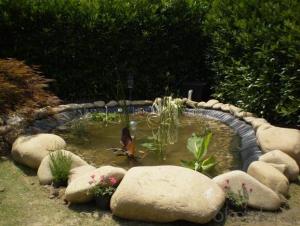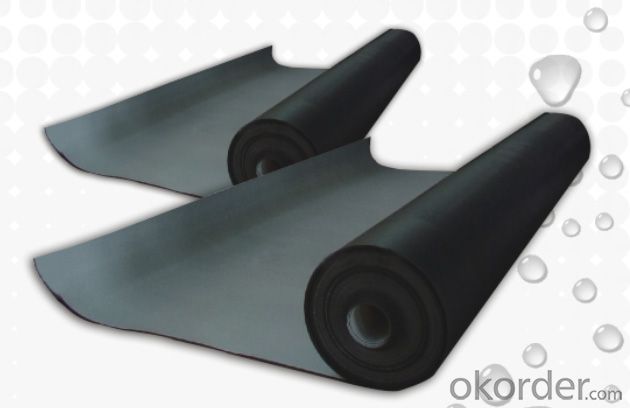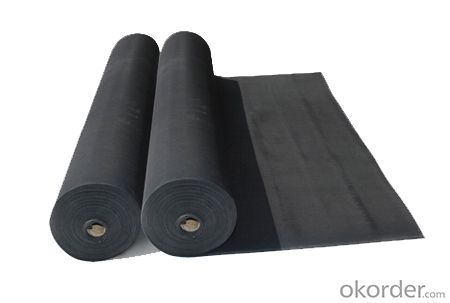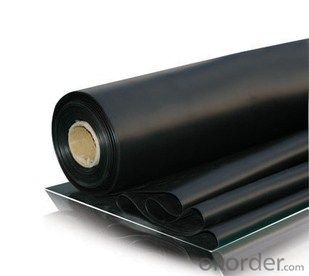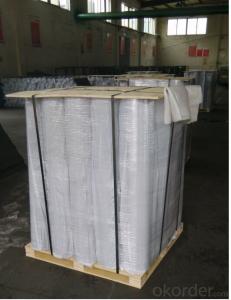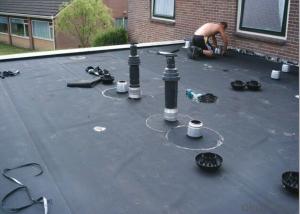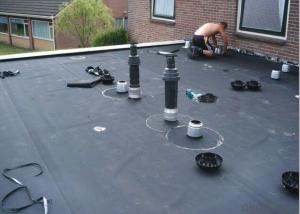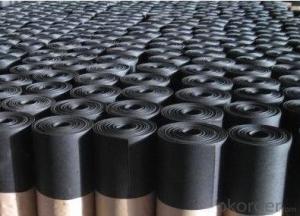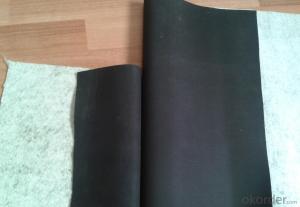EPDM Coiled Waterproof Membrane with Customized Thickness
- Loading Port:
- Shanghai
- Payment Terms:
- TT OR LC
- Min Order Qty:
- 50000 m²
- Supply Capability:
- 5000000 m²/month
OKorder Service Pledge
OKorder Financial Service
You Might Also Like
EPDM Coiled Waterproof Membrane with Customized Thickness
Description Of EPDM Coiled Waterproof Membrane with Customized Thickness:
1. Excellent physical and mechanical performance, high tearing resistance;good deformation adaptability, high puncture resistance;
2. High aging resistance, high UV resistance, anti-acid & alkali;
3. Excellent low & high temperature resistance, innocuous, long life span;
4. Perfect water proof performance, seepage and humidity resistance.
Main Features of EPDM Coiled Waterproof Membrane with Customized Thickness:
A.Polyester based SBS Modified Bitumen Waterproofing Membrane
a. Strong impermeability
b. High tensile strength, elongation, ability to adapt the grassroots shrinkage deformation and cracking
c. Puncture-resistant, broken resistant, tear-resistant
d. The corrosion resistance, resistance to mildew, weathering good
e. Construction convenient, hot-melt can be operated Four Seasons Construction, reliable joints
B. Fiberglass based SBS Modified Bitumen Waterproofing Membrane
a. High tensile strength, stability of a good size
b. High Temperature good performance
c. Damage resistance, corrosion resistance, resistance to mildew, weathering good performance
d. Good construction performance, reliable joints.
Specifications of EPDM Coiled Waterproof Membrane with Customized Thickness:
| Material | EPDM Rubber |
| Size | 1.2m (width)*20m (length) or customized, weldable type 2.05m or 4m width |
| Thick | 1.2mm, 1.5mm, 2.0mm |
| Type | Vulcanized & Weldable |
| Pattern | Non-reinforced (homogeneous) |
| Certificate | ISO9001/14001 |
Applications of EPDM Coiled Waterproof Membrane with Customized Thickness:
geomembrane used in groundsill of road, highway, railway and waterproof layer of swelling clay and wet collapsed loess.Geomembrane can be widely used in areas of garbage burying, waste disposal and underground construction projects.such as below:
- aquaculture ponds
- Ouchi root barrier membrane
- Floating baffles;
- Process wastewater
- Stormwater impoundments;
- Secondary containment;
- Spill containment
- Manure and biogas tanks and covers
- Potable water tanks and covers;
- Sludge Drying beds;
- Bioremediation covers & liners;
- Leachate ponds



IMages of EPDM Coiled Waterproof Membrane with Customized Thickness:




FAQ of EPDM Coiled Waterproof Membrane with Customized Thickness:
1. What are we supplying?
We are specialized in producing Colorful Asphalt Roof Shingle, SBS/APP modified bitumen waterproof membrane, Self adhesive bitumen waterproof membrane, PVC waterproofing membrane, EPDM rubber roofing membrane, Single Component Polyurethane Waterproof Coating, and Spray Polyurea Waterproof Coating
.
2. How Many years experience do we have?
We have been exported to more than 20 countries in the past 15 years.
3. How long do we usually reply your request?
We always reply our customer within 24 hours.
- Q: Can a waterproofing membrane be repaired if damaged?
- Yes, a waterproofing membrane can be repaired if damaged. The extent of the damage will determine the repair method and whether it can be fixed on-site or if a professional needs to be called in. Small punctures or tears in the membrane can often be patched with a sealant or adhesive, while larger or more severe damage may require a section of the membrane to be replaced. It is important to address any damage promptly to prevent further water penetration and potential structural issues.
- Q: Can waterproofing membranes be used on utility manholes?
- Yes, waterproofing membranes can be used on utility manholes. Waterproofing membranes provide a protective layer that prevents water infiltration into the manhole, helping to maintain its structural integrity and prevent damages caused by water exposure.
- Q: Can a waterproofing membrane be used in commercial construction?
- Certainly, a waterproofing membrane is a viable option for utilization in commercial construction. In actuality, it serves as an essential element throughout the construction process. Its purpose is to establish a barrier against moisture, effectively preventing water infiltration and safeguarding the structure from potential water-related harm. This element proves particularly crucial in commercial edifices, where water poses a significant threat to the structural integrity. It can lead to severe problems, including mold proliferation, material deterioration, and even compromise the foundation's stability. Waterproofing membranes find widespread application in various areas of commercial construction, encompassing basements, roofs, foundations, and even external walls. They come in diverse forms, such as sheets, liquid coatings, or spray-applied membranes, allowing for flexibility and adaptability in different construction scenarios. All in all, incorporating a waterproofing membrane in commercial construction endeavors is a prudent investment, ensuring the long-lasting endurance and efficiency of the building.
- Q: Can a waterproofing membrane be used for a hospital?
- Yes, a waterproofing membrane can be used for a hospital. Waterproofing membranes are commonly used in construction projects to prevent moisture infiltration and protect the integrity of the building materials. In a hospital setting, where hygiene and infection control are of utmost importance, it is crucial to maintain a dry and clean environment to prevent the growth of mold, mildew, and bacteria. A waterproofing membrane can help to create a barrier against water and moisture, preventing any potential damage to the structure and ensuring a safe and healthy environment for patients, staff, and visitors. Additionally, waterproofing membranes can also be used in specific areas of a hospital, such as operating rooms or laboratories, where the risk of spills or water exposure is higher. Overall, the use of a waterproofing membrane in a hospital can contribute to maintaining a high standard of cleanliness, safety, and durability in the facility.
- Q: Can a waterproofing membrane be used for a residential building facade?
- A residential building facade can utilize a waterproofing membrane. This material is applied to the exterior surface of the building to prevent water from penetrating and damaging the structure due to moisture. It proves particularly beneficial for residential buildings that are exposed to different weather conditions. The utilization of a waterproofing membrane for a residential building facade offers several advantages. Firstly, it prevents water from seeping through the facade and causing harm to the interior walls, insulation, and other building materials. This ensures a dry and comfortable living environment inside the house. Moreover, a waterproofing membrane extends the lifespan of the building facade by acting as a protective barrier against moisture and water-related issues like mold, mildew growth, and efflorescence. This condition causes discoloration and deterioration of the facade over time due to mineral deposits from water. Furthermore, this type of membrane enhances the energy efficiency of a residential building. It achieves this by preventing water infiltration, thereby maintaining proper insulation and reducing air leakage. This, in turn, reduces the energy required for heating or cooling the building. However, it is crucial to select the appropriate waterproofing membrane for the specific requirements of the residential building facade. There are several options available, including liquid-applied membranes, sheet membranes, and spray-applied membranes. Each option has its own advantages and limitations. Therefore, consulting a professional waterproofing contractor or architect is advisable to determine the most suitable membrane system for the project. Additionally, proper installation and regular maintenance are essential to ensure the effectiveness and longevity of the waterproofing membrane on the residential building facade.
- Q: Can a waterproofing membrane be used on glass block surfaces?
- Yes, a waterproofing membrane can be used on glass block surfaces. Glass block surfaces are often used in areas such as bathrooms or kitchens where waterproofing is essential to prevent water damage. Applying a waterproofing membrane helps to create a barrier that prevents water from penetrating the glass blocks, protecting the underlying structures and materials. The membrane is typically applied to the exterior side of the glass block surface, ensuring that any water that comes into contact with the surface is directed away and does not seep through. It is important to choose a waterproofing membrane that is specifically designed for use on glass block surfaces to ensure proper adhesion and long-lasting protection.
- Q: How is the water level rated and how many grades are used?
- 2, the roof waterproof level 2: Applications: important buildings and high-rise buildings; Waterproof layer of reasonable use of life: 15 years; Waterproof layer selection of materials: should choose high polymer modified asphalt waterproofing membrane, synthetic polymer waterproofing membrane, metal sheet, synthetic polymer waterproof coating, high polymer modified asphalt waterproof coating, fine stone concrete, flat tile, linoleum Tile and other materials; Fortification requirements: two waterproof fortification.
- Q: Can a waterproofing membrane be used in conjunction with other waterproofing methods?
- Indeed, the utilization of a waterproofing membrane in conjunction with other waterproofing methods is possible. In fact, it is quite customary to amalgamate multiple waterproofing techniques in order to offer augmented defense against water intrusion. Primarily, waterproofing membranes are frequently employed as the main layer of waterproofing, serving as a shield against water infiltration. Nevertheless, these membranes can be further reinforced through the utilization of other approaches including sealants, coatings, or drainage systems. These supplementary methods aid in addressing specific vulnerabilities, such as cracks, joints, or areas susceptible to high water pressure. Through the amalgamation of various waterproofing techniques, it becomes feasible to establish a comprehensive and efficacious waterproofing system that provides utmost safeguarding against water damage.
- Q: Can a waterproofing membrane be used in conjunction with expansion joint systems?
- Yes, a waterproofing membrane can be used in conjunction with expansion joint systems. Waterproofing membranes are commonly used to prevent water infiltration and protect structures from moisture damage. Expansion joint systems, on the other hand, are installed to allow for movement and accommodate thermal expansion and contraction in structures. By combining the use of a waterproofing membrane and expansion joint systems, it is possible to provide both waterproofing and movement accommodation in a structure. This ensures that the structure remains protected from water damage while allowing for necessary movement. It is important to properly design and install both the waterproofing membrane and the expansion joint system to ensure their compatibility and effectiveness.
- Q: Can a waterproofing membrane enhance the durability or lifespan of a structure?
- Certainly, the durability and lifespan of a structure can be significantly enhanced with the use of a waterproofing membrane. This type of membrane acts as a protective layer, applied to the exterior of structures like buildings or bridges, with the purpose of preventing water penetration. Essentially, it functions as a barrier that stops water from seeping into the structure and causing harm. Water is a common and destructive element that can negatively impact the longevity of any structure. When water infiltrates a building or any other type of structure, it can lead to a variety of problems, including mold growth, deterioration of building materials, corrosion of metal reinforcements, and even structural instability. However, by implementing a waterproofing membrane, these risks can be significantly reduced or even eliminated altogether. The installation of a waterproofing membrane not only prevents water from entering, but it also safeguards the structure against other environmental factors such as moisture, humidity, and freeze-thaw cycles. Acting as a shield, it ensures that the building materials remain intact and reduces the likelihood of cracks, leaks, and other forms of structural damage. By enhancing a structure's durability, a waterproofing membrane can effectively prolong its lifespan. Considered a long-term investment, it helps prevent costly repairs and maintenance caused by water-related issues. By keeping the structure dry and protected, it adds years or even decades to its lifespan, ultimately saving both time and money in the long run. In conclusion, a waterproofing membrane is an essential component for maintaining the durability and lifespan of any structure. By preventing water infiltration and protecting the building materials from damage, it ensures the longevity of the structure and provides peace of mind to its owners and occupants.
Send your message to us
EPDM Coiled Waterproof Membrane with Customized Thickness
- Loading Port:
- Shanghai
- Payment Terms:
- TT OR LC
- Min Order Qty:
- 50000 m²
- Supply Capability:
- 5000000 m²/month
OKorder Service Pledge
OKorder Financial Service
Similar products
Hot products
Hot Searches
Related keywords
